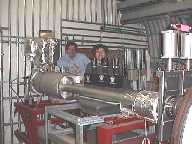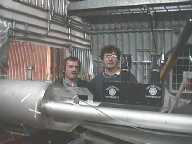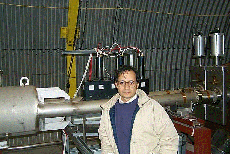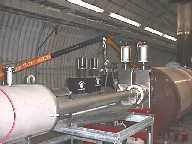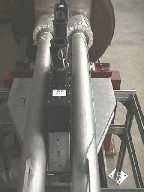The RHIC Zero Degree
Calorimeters
and
PHENIX ZDC Shower Maximum Detector
The Zero Degree
calorimeters are small transverse area hadron calorimeters
located downstream of the DX dipole magnets in each of the Heavy
Ion Experiments at RHIC. The detectors measure neutral energy within a
2 mrad cone about the beam direction (since charged particles are swept
away by the DX magnet). The actual detector location is ~18m from the
interaction point and the horizontal acceptance is to +/- 5cms.
The design is based on the requirements for Au-Au
runs but the dettectors are also used in p-p and d-Au runs.
The detectors serve two roles: The energy
measurement basically counts the number of free "spectator" neutrons.
This is used for event-by-event characterization(usually in conjuction
with the BBC). Also coincidence signals from
detectors on either side of the interaction region are used for
luminosity
monitoring. During 200 GeV Au-Au running (ie in Run IV) the ZDC
coincidence rate has an effective cross section of
10.4 barns (with an uncertainty of about 5%).
The energy
scale of the ZDC is determined from the inclusive spectrum
obtained with RHIC data. You can usually make out the first few peaks
(ie 1n and 2n, etc) in this spectrum which gives you the best possible
Energy calibration. However we try to "dead-reckon" the relative gains
of the 3 PMT's- each measuring successive depth segments in the
calorimeter- using cosmic ray data. Typically this has been succesful
and the width of the 1-n peak is about 20%, consistent with what
we expected for optimal balancing.
The ZDC timing resolution is ~ 100 psec
depending on the electronics setup, empirical slewing corrections.. (in
other words depending on which experiment you're in). Since you measure
time in 2 ZDC's, on either side of the IR, you can derive 2 quantities
from them- the vertex position and the event time.
The PHENIX
Shower Max Detectors(SMD) are layers of position sensitive
hodoscopes sandwiched between the first and second module of the ZDC's.
Since a ZDC module is 2 hadronic interaction lengths deep, the actual
amplitude measured in the Shower Max detector will fluctuate from one
shower to another (but less so in a typical event with many neutrons).
The purpose of the SMD is to measure the centroid of
showers in the ZDC in 2 coordinates-x and y. The first SMD layer has 21
strips of 0.5 cm *0.5 cm scintillators each with wavelength shifter
fiber readout. Groups of 3 fibers are read out by a single channel of a
multi-anode PMT. So the total width of the SMD, 10.5 cms, is
subdivided into 7 samples. In d-Au runs (Run-3) the horizontal
measurement accuracy of the centroid was about 0.1 to 0.2 mm and
correlated with accelerator instrumentation beam position. Similarly,
the vertical coordinate has 8 elements of 4 scintillator strips.

The ZDC's are
described in the following NIM article (). Also relevant is the
following article in Phys. Rev. Letters which analyzes the basic cross
sections contributing to the ZDC data. The measurements relate directly
to the NIM article discussing the calculation of cross sections.
C. Adler et al., Nucl. Instr. And Meth. A470, 488 (01) or in
archives at nucl-ex/0008005.
M. Chiu et al. Phys. Rev. Lett. 89 (02) 012302
A. J. Baltz C. Chasman and S. White, Nucl. Instr. And Meth. A417, 1
(98) or at nucl-ex/9801002
Some of the design considerations are based
on the NA49 measurement in which we tried to understand the role of
free neutron measurement as opposed the more traditional fixed target
implementation.
H.~Appelshauser et al.[NA49 Collaboration],``Spectator nucleons in Pb + Pb collisions at 158-A-GeV"
Eur. Phys. J. A2, 383 (1998)
Info for PHENIX shifts
on ZDC/SMD operation
ZDC/SMD keeps an electronic logbook location
http://replicator.phenix.bnl.gov:8080/zdc/
The High Voltage of ZDC/SMD shares a crate with BBC. Also the FEM's for
ZDC/SMD are the same as BBC at the "back end".
HV is accessed through the corrsponding line in
http://www.phenix.bnl.gov/phenix/WWW/run/04/shift_ass1/hv_monitoring.html.
The ZDC (2* 3 PMT's) and SMD (2 MAPT's) are monitored with led flasher
data which you can track with the on-line plots.
Also see Denisov's zdc tutorial at
http://www.phenix.bnl.gov/phenix/WWW/run/04/subsys_tutorials/zdc/
The first ZDC module was
installed
in the RHIC tunnel on March 19th '99.
Photos
Physics Links

Send mail to: Sebastian
White: E-Mail Address: white1@bnl.gov
(last updated: Nov. 2003)
![]()
![]()
